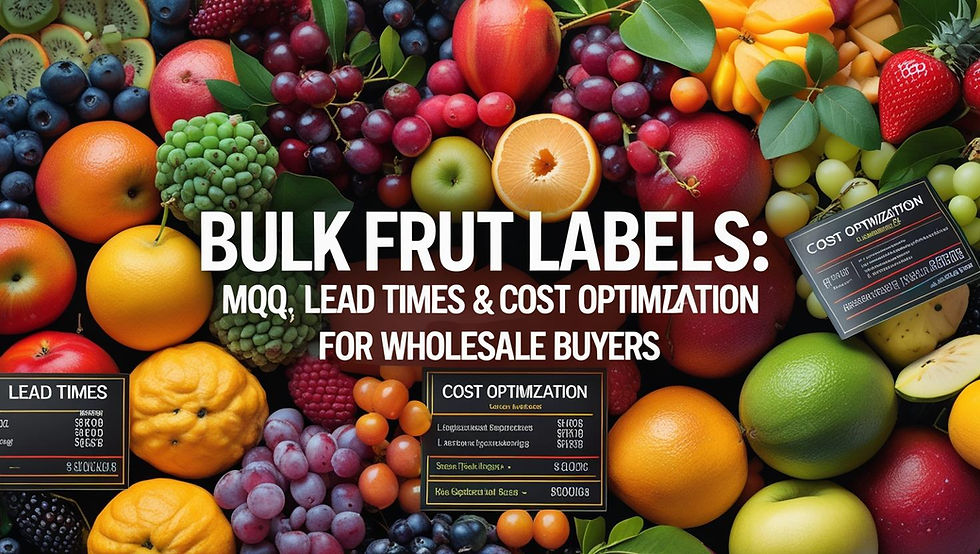Bulk Fruit Labels: MOQ, Lead Times & Cost Optimization for Wholesale Buyers
- Hongda Pack
- Aug 22
- 4 min read

In today’s competitive fresh produce market, fruit labels are more than just stickers on apples, oranges, or pears. They represent branding, compliance, traceability, and customer trust. For wholesale buyers, especially retailers, distributors, and exporters, purchasing bulk fruit labels involves more than simply placing an order. Factors like Minimum Order Quantity (MOQ), lead times, and cost optimization play a vital role in supply chain efficiency and profitability.
This guide explores how wholesale buyers can strategically manage bulk fruit label purchases. By understanding industry practices and negotiating smarter, businesses can reduce costs, streamline production, and strengthen their brand identity in the marketplace.
The Importance of Bulk Fruit Labels for Businesses
Fruit labels serve multiple functions beyond aesthetics. They are critical for compliance, marketing, and consumer information.
Brand recognition – Logos and consistent designs help retailers and growers stand out.
Traceability – Labels with barcodes or QR codes improve tracking across the supply chain.
Compliance – Labels ensure adherence to country-specific food safety regulations.
Consumer engagement – High-quality fruit labels create a sense of freshness and trust.
When purchased in bulk, fruit labels become a strategic asset that influences cost efficiency, supply continuity, and overall product perception.
MOQ in Bulk Fruit Label Orders
What is MOQ?
MOQ, or Minimum Order Quantity, refers to the smallest batch of labels a supplier is willing to produce. For bulk fruit label buyers, MOQs typically vary based on design complexity, printing technology, and material type.
Factors Affecting MOQ
Printing method – Digital printing often allows smaller runs, while flexographic or offset printing may require higher MOQs.
Label material – Biodegradable or specialty adhesives usually require larger runs to justify setup costs.
Customization level – Multi-color branding or special finishes increase MOQ compared to plain, one-color labels.
How to Negotiate MOQ Effectively
Consolidate designs across multiple fruit varieties to reach MOQ.
Discuss tiered pricing where higher quantities lower unit costs.
Work with suppliers who offer mixed batches for different SKUs within one production run.
For wholesale buyers, balancing MOQ with actual demand ensures labels are neither overstocked nor underproduced.
Lead Times in Fruit Label Production
Understanding Lead Times
Lead time refers to the total duration from placing an order to receiving the final shipment. For fruit labels, lead times can vary between two to eight weeks depending on production complexity and supplier location.
Factors That Influence Lead Times
Artwork approval – Delays in confirming designs can extend lead times.
Supplier production schedules – Peak seasons such as harvest time may cause longer waits.
Shipping and logistics – International freight adds extra time for customs clearance.
Technology used – Digital printing often has shorter turnaround than traditional methods.
Strategies to Manage Lead Times
Place orders ahead of peak demand to avoid supply chain bottlenecks.
Keep reorder history with suppliers to speed up repeat purchases.
Work with multiple label vendors to ensure flexibility and backup options.
or wholesale buyers, accurate forecasting and supplier collaboration are key to reducing lead-time risks.
Cost Optimization for Bulk Fruit Labels
1. Material Selection
Label material impacts both cost and functionality. Paper labels are cost-effective but less durable for cold storage. Film-based labels are moisture resistant but more expensive. Buyers should weigh durability against cost based on storage and shipping conditions.
2. Printing Technology
Digital printing – Ideal for smaller runs with multiple SKUs, cost-efficient for high customization.
Flexographic printing – Better for large consistent runs, offering lower unit costs.
Matching printing technology to order size is one of the most effective ways to control expenses.
3. Design Efficiency
Complex designs with multiple colors, foils, or embossing raise costs. Streamlined designs with fewer color layers reduce expenses while still maintaining brand appeal.
4. Volume Discounts
Suppliers typically offer lower per-unit costs at higher volumes. Wholesale buyers should plan purchases in bulk cycles to secure better pricing.
5. Supply Chain Partnerships
Building long-term relationships with label suppliers leads to negotiated discounts, faster turnaround, and flexible payment terms.
6. Waste Reduction
Over-ordering leads to obsolete inventory if branding or regulatory requirements change. Buyers should order smartly in line with sales forecasts.
Balancing Quality with Cost Efficiency
Wholesale buyers often face the challenge of choosing between high-quality labels and budget-friendly solutions. While cost savings are critical, poor-quality labels that peel off, fade, or fail compliance checks can damage brand reputation and result in penalties.
Smart buyers optimize costs without compromising on quality by:
Choosing materials that suit environmental conditions.
Simplifying designs without losing brand identity.
Working with suppliers who use modern printing methods to deliver high output at controlled costs.
Global Trends in Bulk Fruit Labels
Eco-friendly materials – Retailers increasingly demand biodegradable adhesives and recyclable labels.
Smart labels – QR codes and barcodes for better traceability and consumer interaction.
Customization – Private label fruit branding is growing in importance, especially for premium markets.
Automation – Many suppliers now integrate label application with packing lines for higher efficiency.
Staying aware of these trends helps wholesale buyers choose label suppliers that are aligned with future market demands.
Best Practices for Wholesale Buyers
Forecast demand accurately to avoid overstocking or under-ordering labels.
Negotiate MOQ flexibility with suppliers for mixed-product runs.
Plan orders early to offset production lead times.
Standardize label sizes across different fruit SKUs to reduce setup costs.
Adopt sustainable practices to align with global market trends.
Conclusion
Bulk fruit labels are an essential component of branding, compliance, and supply chain efficiency for wholesale buyers. Understanding MOQ, managing lead times effectively, and implementing cost optimization strategies can make the difference between operational challenges and long-term profitability. Choose reputable brands as your fruit label supplier as they provide high quality labels with low MOQ requirements and worldwide delivery.
By choosing the right suppliers, planning strategically, and balancing cost with quality, wholesale buyers can ensure that their fruit labels not only meet compliance requirements but also add value to their business and brand identity.



Comments